Marketing Strategies: Ansoff Matrix, 7Ps, SWOT & Competitive Edge
VerifiedAdded on 2024/06/21
|12
|1809
|490
Report
AI Summary
This report delves into key marketing strategies essential for business growth and competitiveness. It highlights the significance of the 7Ps of the marketing mix in creating customer value and explores how the marketing function, utilizing tools like SWOT analysis, can help businesses understand their strengths, weaknesses, opportunities, and threats. The report further discusses the Ansoff Matrix as a strategic planning tool for market and product development, outlining its four strategies: market penetration, product development, market development, and diversification, along with their associated risks. Additionally, it emphasizes the importance of digital marketing, covering its various channels and benefits, such as broader reach, cost-effectiveness, and data-driven targeting, for enhancing business performance and achieving a competitive edge in the market.

INTRODUCTION TO MARKETING
1
1
Paraphrase This Document
Need a fresh take? Get an instant paraphrase of this document with our AI Paraphraser
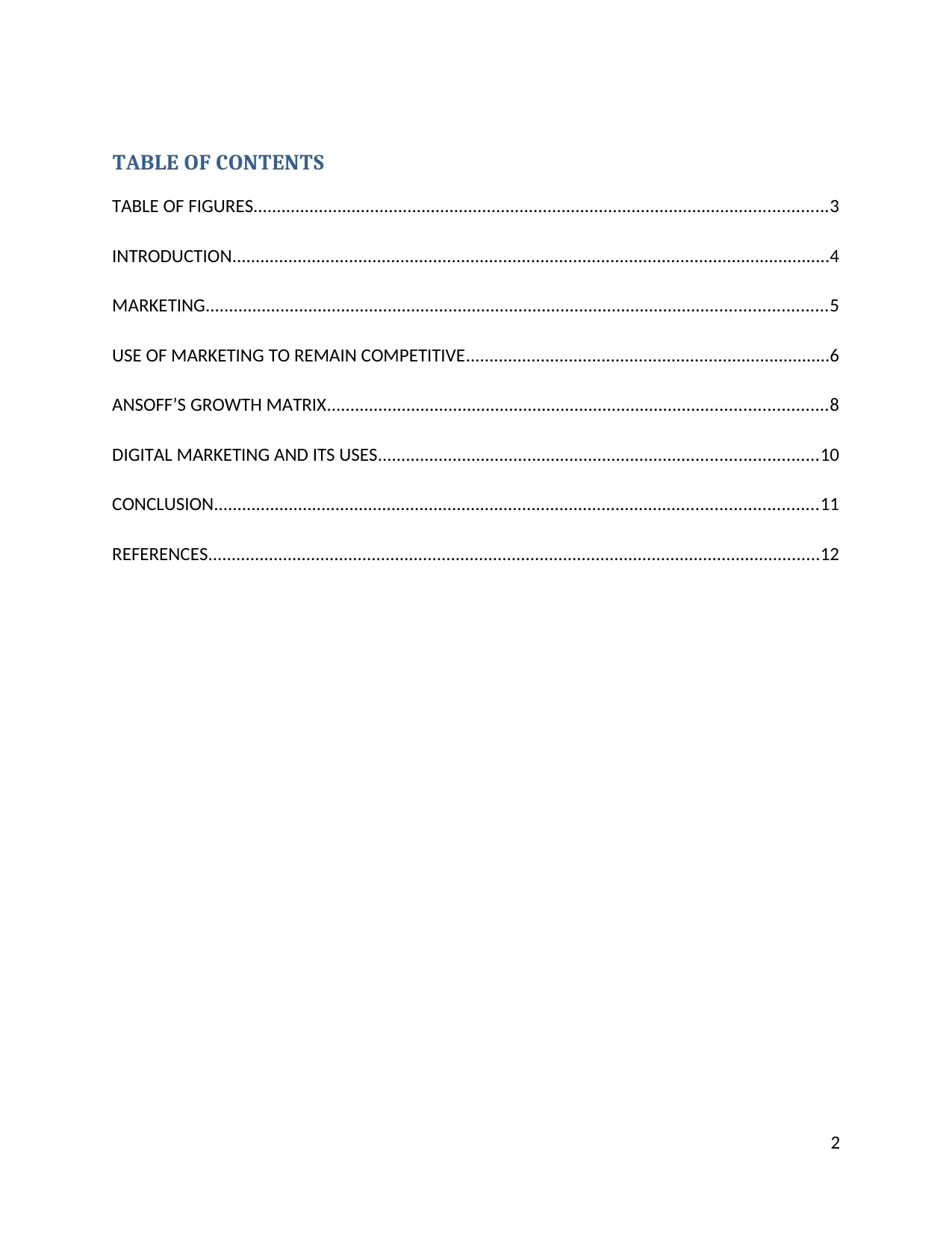
TABLE OF CONTENTS
TABLE OF FIGURES...........................................................................................................................3
INTRODUCTION................................................................................................................................4
MARKETING.....................................................................................................................................5
USE OF MARKETING TO REMAIN COMPETITIVE..............................................................................6
ANSOFF’S GROWTH MATRIX...........................................................................................................8
DIGITAL MARKETING AND ITS USES..............................................................................................10
CONCLUSION.................................................................................................................................11
REFERENCES...................................................................................................................................12
2
TABLE OF FIGURES...........................................................................................................................3
INTRODUCTION................................................................................................................................4
MARKETING.....................................................................................................................................5
USE OF MARKETING TO REMAIN COMPETITIVE..............................................................................6
ANSOFF’S GROWTH MATRIX...........................................................................................................8
DIGITAL MARKETING AND ITS USES..............................................................................................10
CONCLUSION.................................................................................................................................11
REFERENCES...................................................................................................................................12
2

TABLE OF FIGURES
Figure 1: 7Ps of marketing mix........................................................................................................5
Figure 2: Ansoff matrix....................................................................................................................8
3
Figure 1: 7Ps of marketing mix........................................................................................................5
Figure 2: Ansoff matrix....................................................................................................................8
3
⊘ This is a preview!⊘
Do you want full access?
Subscribe today to unlock all pages.

Trusted by 1+ million students worldwide
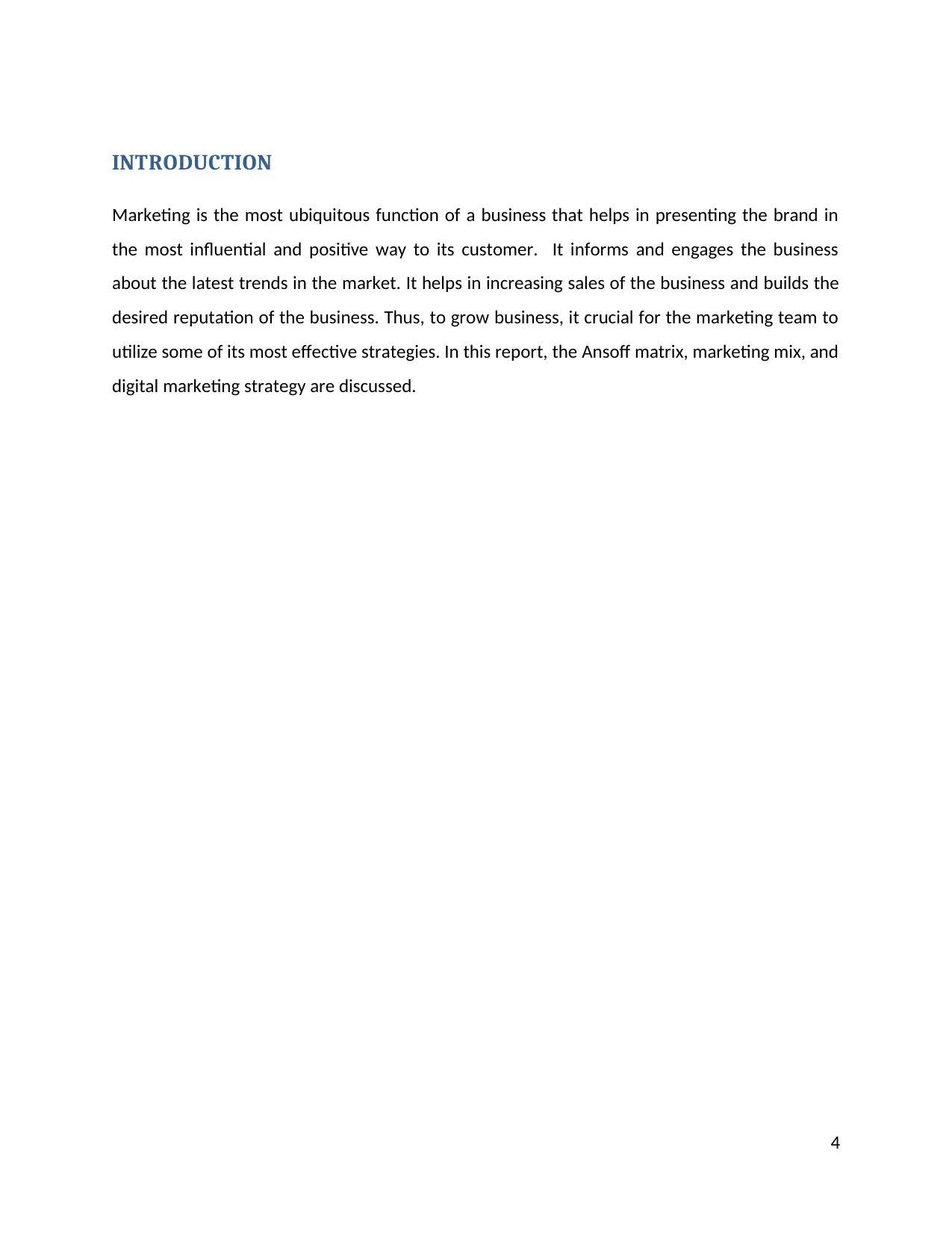
INTRODUCTION
Marketing is the most ubiquitous function of a business that helps in presenting the brand in
the most influential and positive way to its customer. It informs and engages the business
about the latest trends in the market. It helps in increasing sales of the business and builds the
desired reputation of the business. Thus, to grow business, it crucial for the marketing team to
utilize some of its most effective strategies. In this report, the Ansoff matrix, marketing mix, and
digital marketing strategy are discussed.
4
Marketing is the most ubiquitous function of a business that helps in presenting the brand in
the most influential and positive way to its customer. It informs and engages the business
about the latest trends in the market. It helps in increasing sales of the business and builds the
desired reputation of the business. Thus, to grow business, it crucial for the marketing team to
utilize some of its most effective strategies. In this report, the Ansoff matrix, marketing mix, and
digital marketing strategy are discussed.
4
Paraphrase This Document
Need a fresh take? Get an instant paraphrase of this document with our AI Paraphraser
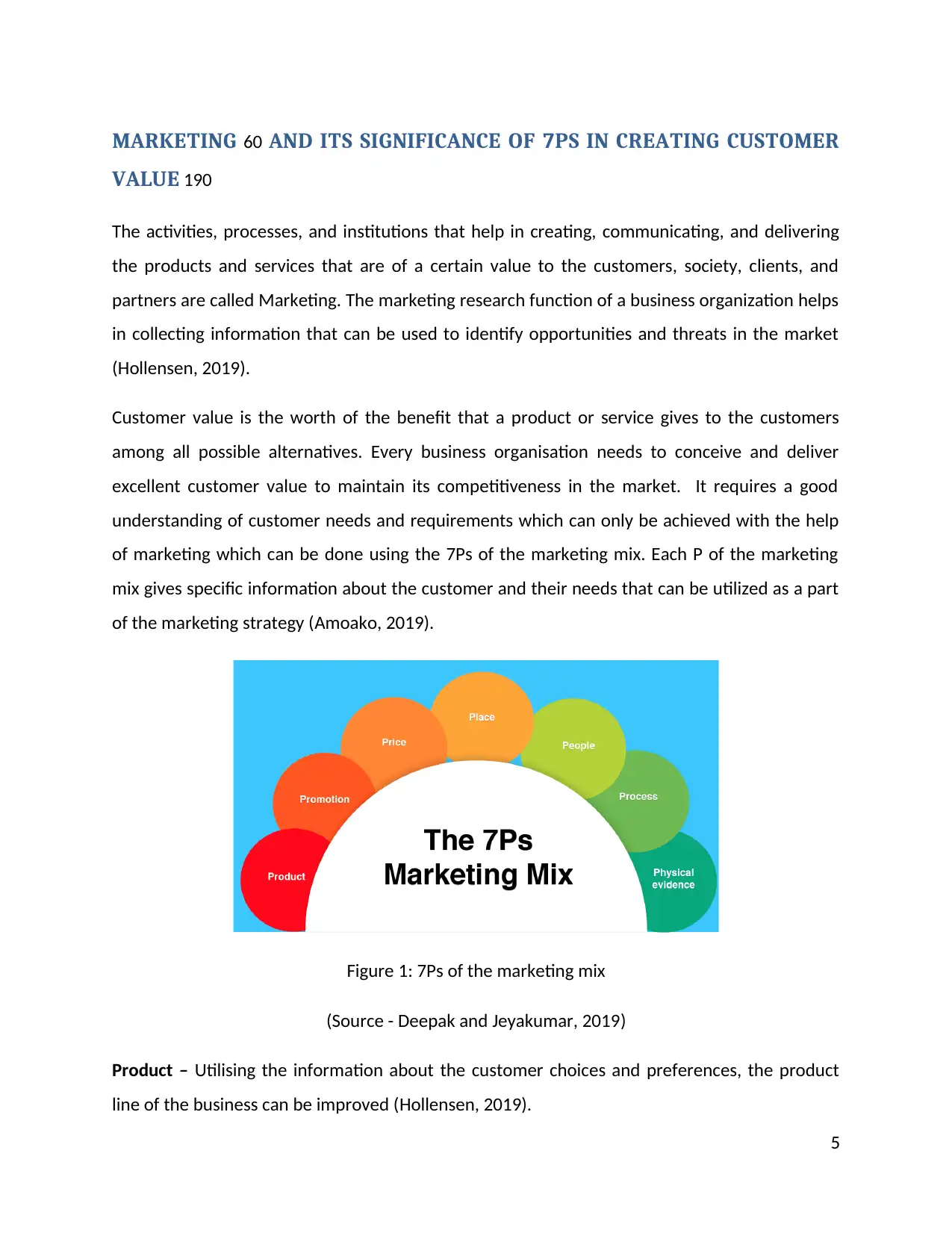
MARKETING 60 AND ITS SIGNIFICANCE OF 7PS IN CREATING CUSTOMER
VALUE 190
The activities, processes, and institutions that help in creating, communicating, and delivering
the products and services that are of a certain value to the customers, society, clients, and
partners are called Marketing. The marketing research function of a business organization helps
in collecting information that can be used to identify opportunities and threats in the market
(Hollensen, 2019).
Customer value is the worth of the benefit that a product or service gives to the customers
among all possible alternatives. Every business organisation needs to conceive and deliver
excellent customer value to maintain its competitiveness in the market. It requires a good
understanding of customer needs and requirements which can only be achieved with the help
of marketing which can be done using the 7Ps of the marketing mix. Each P of the marketing
mix gives specific information about the customer and their needs that can be utilized as a part
of the marketing strategy (Amoako, 2019).
Figure 1: 7Ps of the marketing mix
(Source - Deepak and Jeyakumar, 2019)
Product – Utilising the information about the customer choices and preferences, the product
line of the business can be improved (Hollensen, 2019).
5
VALUE 190
The activities, processes, and institutions that help in creating, communicating, and delivering
the products and services that are of a certain value to the customers, society, clients, and
partners are called Marketing. The marketing research function of a business organization helps
in collecting information that can be used to identify opportunities and threats in the market
(Hollensen, 2019).
Customer value is the worth of the benefit that a product or service gives to the customers
among all possible alternatives. Every business organisation needs to conceive and deliver
excellent customer value to maintain its competitiveness in the market. It requires a good
understanding of customer needs and requirements which can only be achieved with the help
of marketing which can be done using the 7Ps of the marketing mix. Each P of the marketing
mix gives specific information about the customer and their needs that can be utilized as a part
of the marketing strategy (Amoako, 2019).
Figure 1: 7Ps of the marketing mix
(Source - Deepak and Jeyakumar, 2019)
Product – Utilising the information about the customer choices and preferences, the product
line of the business can be improved (Hollensen, 2019).
5
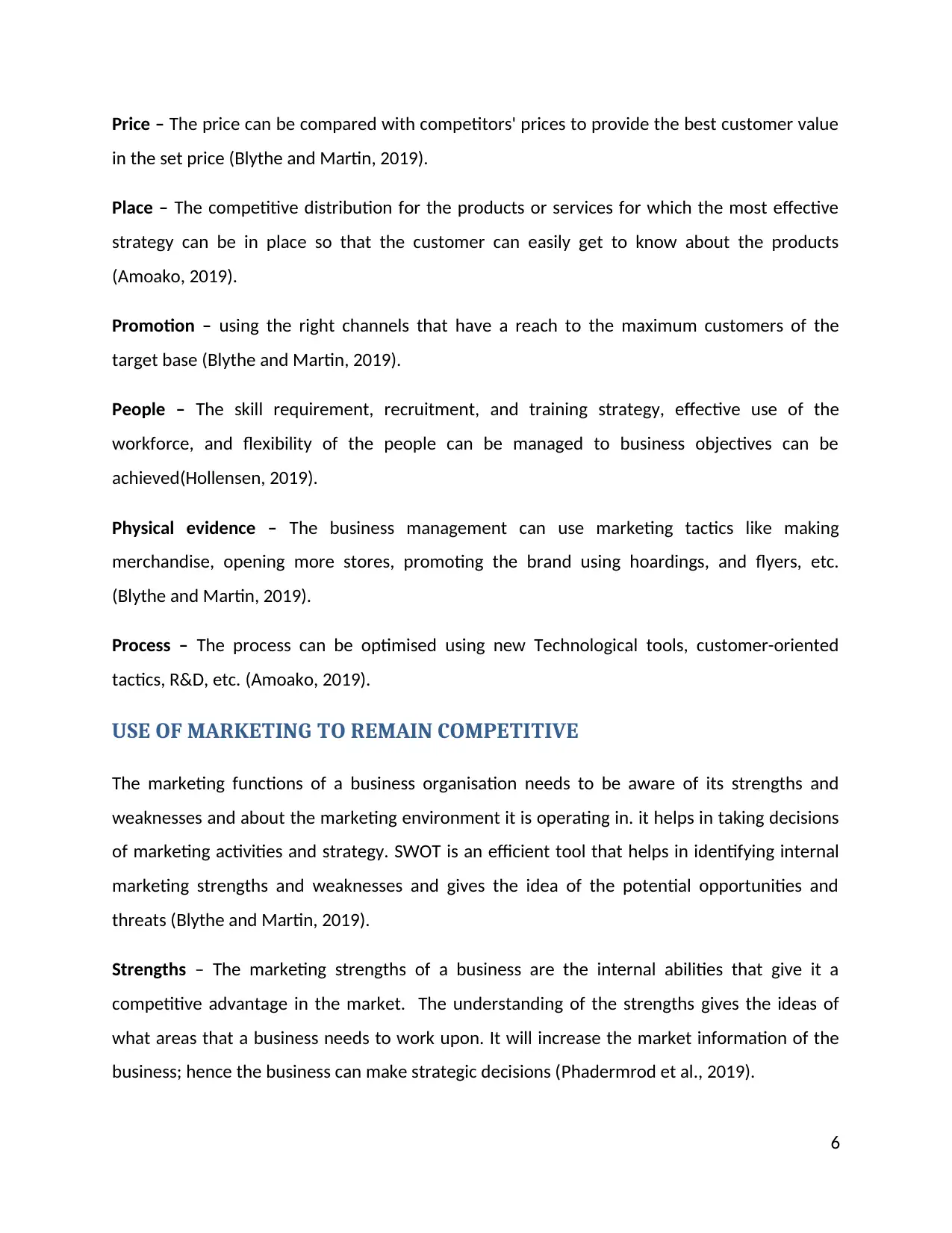
Price – The price can be compared with competitors' prices to provide the best customer value
in the set price (Blythe and Martin, 2019).
Place – The competitive distribution for the products or services for which the most effective
strategy can be in place so that the customer can easily get to know about the products
(Amoako, 2019).
Promotion – using the right channels that have a reach to the maximum customers of the
target base (Blythe and Martin, 2019).
People – The skill requirement, recruitment, and training strategy, effective use of the
workforce, and flexibility of the people can be managed to business objectives can be
achieved(Hollensen, 2019).
Physical evidence – The business management can use marketing tactics like making
merchandise, opening more stores, promoting the brand using hoardings, and flyers, etc.
(Blythe and Martin, 2019).
Process – The process can be optimised using new Technological tools, customer-oriented
tactics, R&D, etc. (Amoako, 2019).
USE OF MARKETING TO REMAIN COMPETITIVE
The marketing functions of a business organisation needs to be aware of its strengths and
weaknesses and about the marketing environment it is operating in. it helps in taking decisions
of marketing activities and strategy. SWOT is an efficient tool that helps in identifying internal
marketing strengths and weaknesses and gives the idea of the potential opportunities and
threats (Blythe and Martin, 2019).
Strengths – The marketing strengths of a business are the internal abilities that give it a
competitive advantage in the market. The understanding of the strengths gives the ideas of
what areas that a business needs to work upon. It will increase the market information of the
business; hence the business can make strategic decisions (Phadermrod et al., 2019).
6
in the set price (Blythe and Martin, 2019).
Place – The competitive distribution for the products or services for which the most effective
strategy can be in place so that the customer can easily get to know about the products
(Amoako, 2019).
Promotion – using the right channels that have a reach to the maximum customers of the
target base (Blythe and Martin, 2019).
People – The skill requirement, recruitment, and training strategy, effective use of the
workforce, and flexibility of the people can be managed to business objectives can be
achieved(Hollensen, 2019).
Physical evidence – The business management can use marketing tactics like making
merchandise, opening more stores, promoting the brand using hoardings, and flyers, etc.
(Blythe and Martin, 2019).
Process – The process can be optimised using new Technological tools, customer-oriented
tactics, R&D, etc. (Amoako, 2019).
USE OF MARKETING TO REMAIN COMPETITIVE
The marketing functions of a business organisation needs to be aware of its strengths and
weaknesses and about the marketing environment it is operating in. it helps in taking decisions
of marketing activities and strategy. SWOT is an efficient tool that helps in identifying internal
marketing strengths and weaknesses and gives the idea of the potential opportunities and
threats (Blythe and Martin, 2019).
Strengths – The marketing strengths of a business are the internal abilities that give it a
competitive advantage in the market. The understanding of the strengths gives the ideas of
what areas that a business needs to work upon. It will increase the market information of the
business; hence the business can make strategic decisions (Phadermrod et al., 2019).
6
⊘ This is a preview!⊘
Do you want full access?
Subscribe today to unlock all pages.

Trusted by 1+ million students worldwide
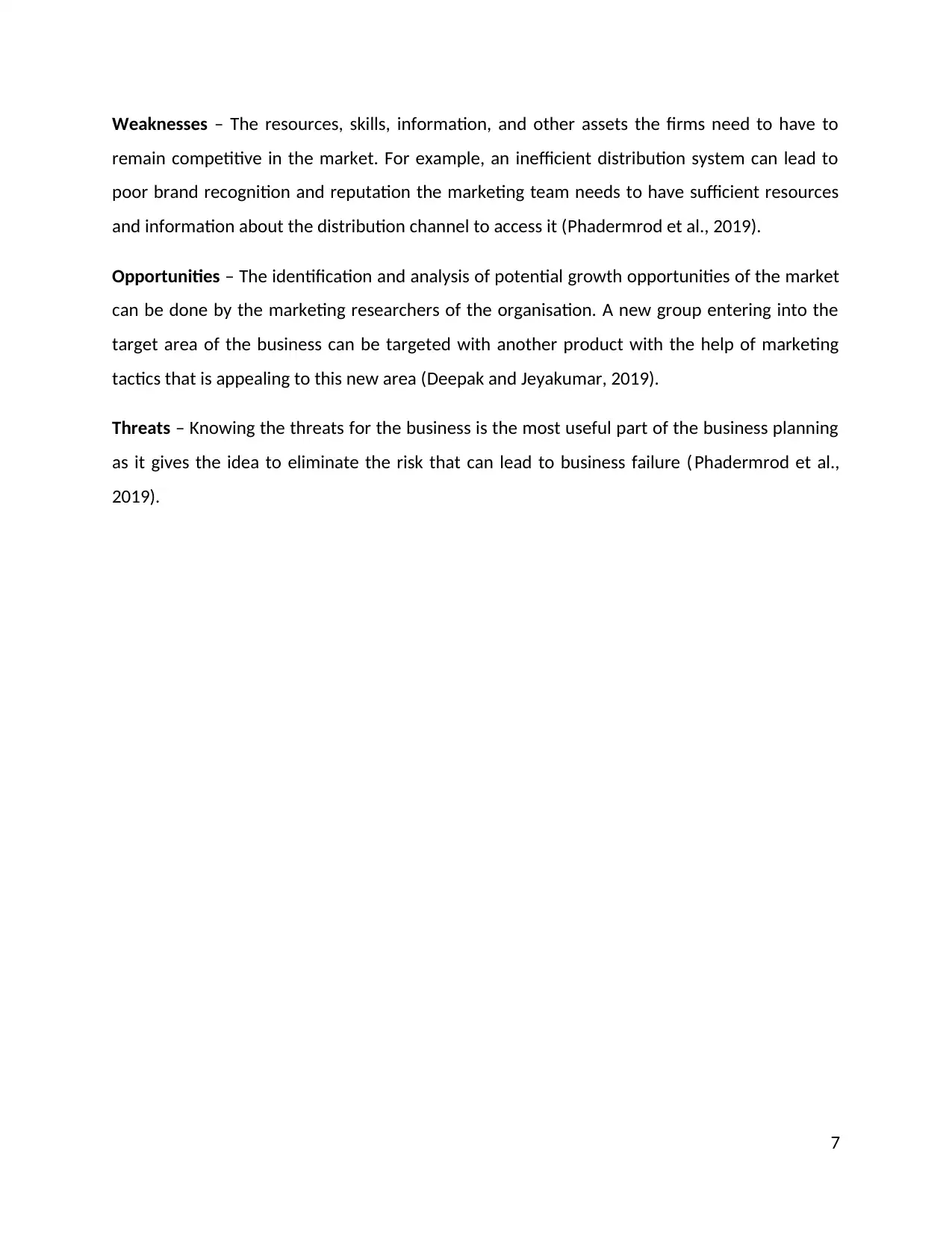
Weaknesses – The resources, skills, information, and other assets the firms need to have to
remain competitive in the market. For example, an inefficient distribution system can lead to
poor brand recognition and reputation the marketing team needs to have sufficient resources
and information about the distribution channel to access it (Phadermrod et al., 2019).
Opportunities – The identification and analysis of potential growth opportunities of the market
can be done by the marketing researchers of the organisation. A new group entering into the
target area of the business can be targeted with another product with the help of marketing
tactics that is appealing to this new area (Deepak and Jeyakumar, 2019).
Threats – Knowing the threats for the business is the most useful part of the business planning
as it gives the idea to eliminate the risk that can lead to business failure ( Phadermrod et al.,
2019).
7
remain competitive in the market. For example, an inefficient distribution system can lead to
poor brand recognition and reputation the marketing team needs to have sufficient resources
and information about the distribution channel to access it (Phadermrod et al., 2019).
Opportunities – The identification and analysis of potential growth opportunities of the market
can be done by the marketing researchers of the organisation. A new group entering into the
target area of the business can be targeted with another product with the help of marketing
tactics that is appealing to this new area (Deepak and Jeyakumar, 2019).
Threats – Knowing the threats for the business is the most useful part of the business planning
as it gives the idea to eliminate the risk that can lead to business failure ( Phadermrod et al.,
2019).
7
Paraphrase This Document
Need a fresh take? Get an instant paraphrase of this document with our AI Paraphraser
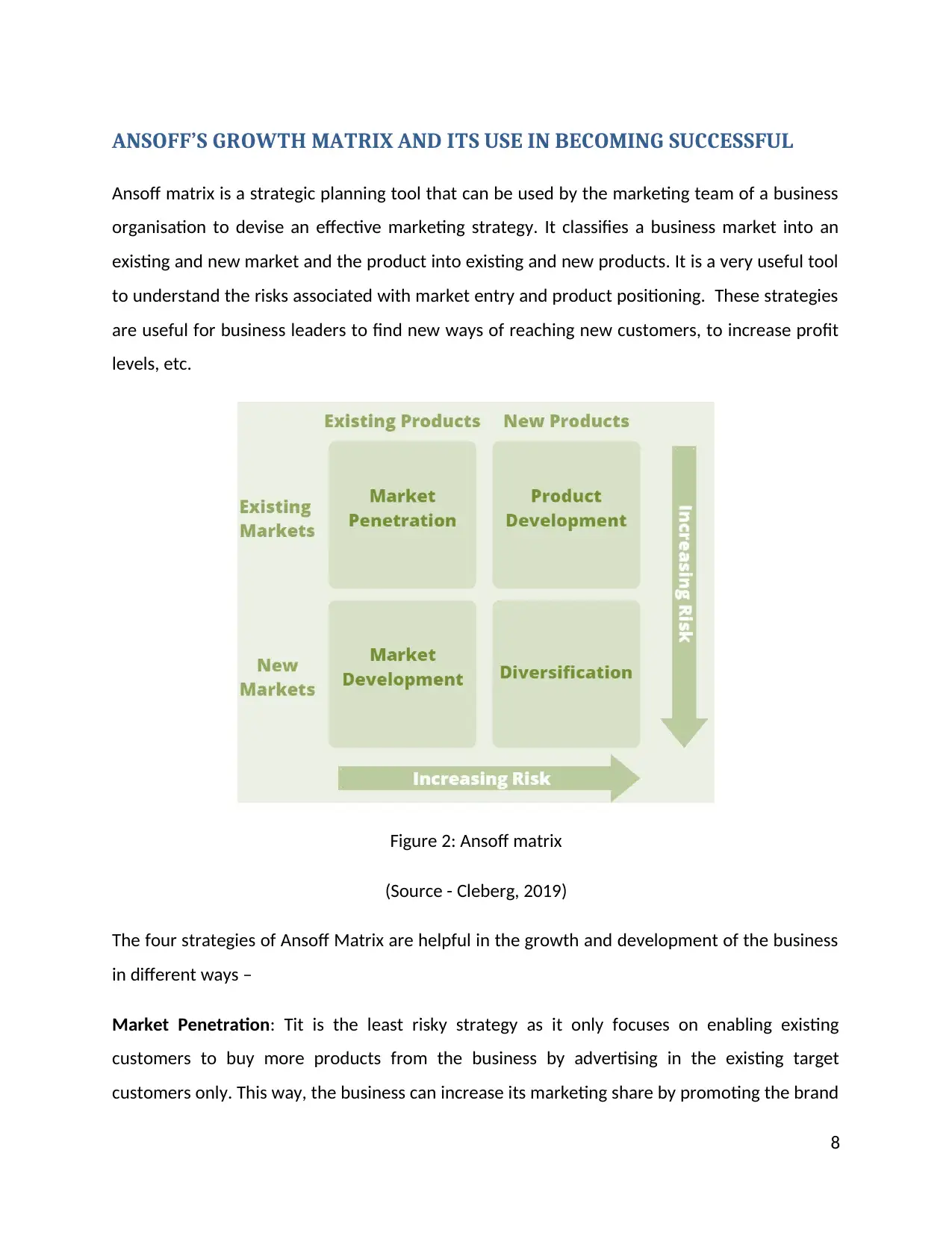
ANSOFF’S GROWTH MATRIX AND ITS USE IN BECOMING SUCCESSFUL
Ansoff matrix is a strategic planning tool that can be used by the marketing team of a business
organisation to devise an effective marketing strategy. It classifies a business market into an
existing and new market and the product into existing and new products. It is a very useful tool
to understand the risks associated with market entry and product positioning. These strategies
are useful for business leaders to find new ways of reaching new customers, to increase profit
levels, etc.
Figure 2: Ansoff matrix
(Source - Cleberg, 2019)
The four strategies of Ansoff Matrix are helpful in the growth and development of the business
in different ways –
Market Penetration: Tit is the least risky strategy as it only focuses on enabling existing
customers to buy more products from the business by advertising in the existing target
customers only. This way, the business can increase its marketing share by promoting the brand
8
Ansoff matrix is a strategic planning tool that can be used by the marketing team of a business
organisation to devise an effective marketing strategy. It classifies a business market into an
existing and new market and the product into existing and new products. It is a very useful tool
to understand the risks associated with market entry and product positioning. These strategies
are useful for business leaders to find new ways of reaching new customers, to increase profit
levels, etc.
Figure 2: Ansoff matrix
(Source - Cleberg, 2019)
The four strategies of Ansoff Matrix are helpful in the growth and development of the business
in different ways –
Market Penetration: Tit is the least risky strategy as it only focuses on enabling existing
customers to buy more products from the business by advertising in the existing target
customers only. This way, the business can increase its marketing share by promoting the brand
8
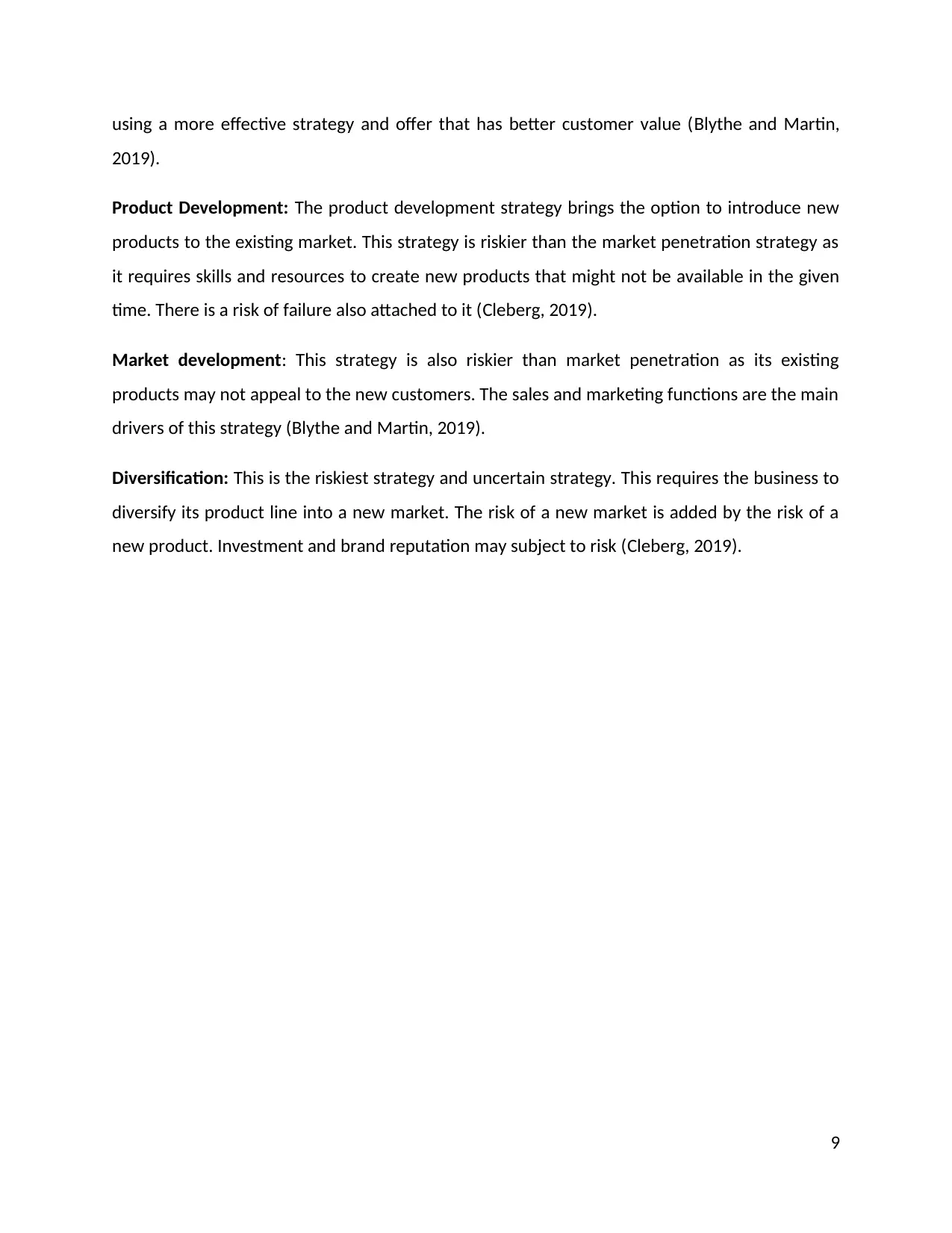
using a more effective strategy and offer that has better customer value (Blythe and Martin,
2019).
Product Development: The product development strategy brings the option to introduce new
products to the existing market. This strategy is riskier than the market penetration strategy as
it requires skills and resources to create new products that might not be available in the given
time. There is a risk of failure also attached to it (Cleberg, 2019).
Market development: This strategy is also riskier than market penetration as its existing
products may not appeal to the new customers. The sales and marketing functions are the main
drivers of this strategy (Blythe and Martin, 2019).
Diversification: This is the riskiest strategy and uncertain strategy. This requires the business to
diversify its product line into a new market. The risk of a new market is added by the risk of a
new product. Investment and brand reputation may subject to risk (Cleberg, 2019).
9
2019).
Product Development: The product development strategy brings the option to introduce new
products to the existing market. This strategy is riskier than the market penetration strategy as
it requires skills and resources to create new products that might not be available in the given
time. There is a risk of failure also attached to it (Cleberg, 2019).
Market development: This strategy is also riskier than market penetration as its existing
products may not appeal to the new customers. The sales and marketing functions are the main
drivers of this strategy (Blythe and Martin, 2019).
Diversification: This is the riskiest strategy and uncertain strategy. This requires the business to
diversify its product line into a new market. The risk of a new market is added by the risk of a
new product. Investment and brand reputation may subject to risk (Cleberg, 2019).
9
⊘ This is a preview!⊘
Do you want full access?
Subscribe today to unlock all pages.

Trusted by 1+ million students worldwide
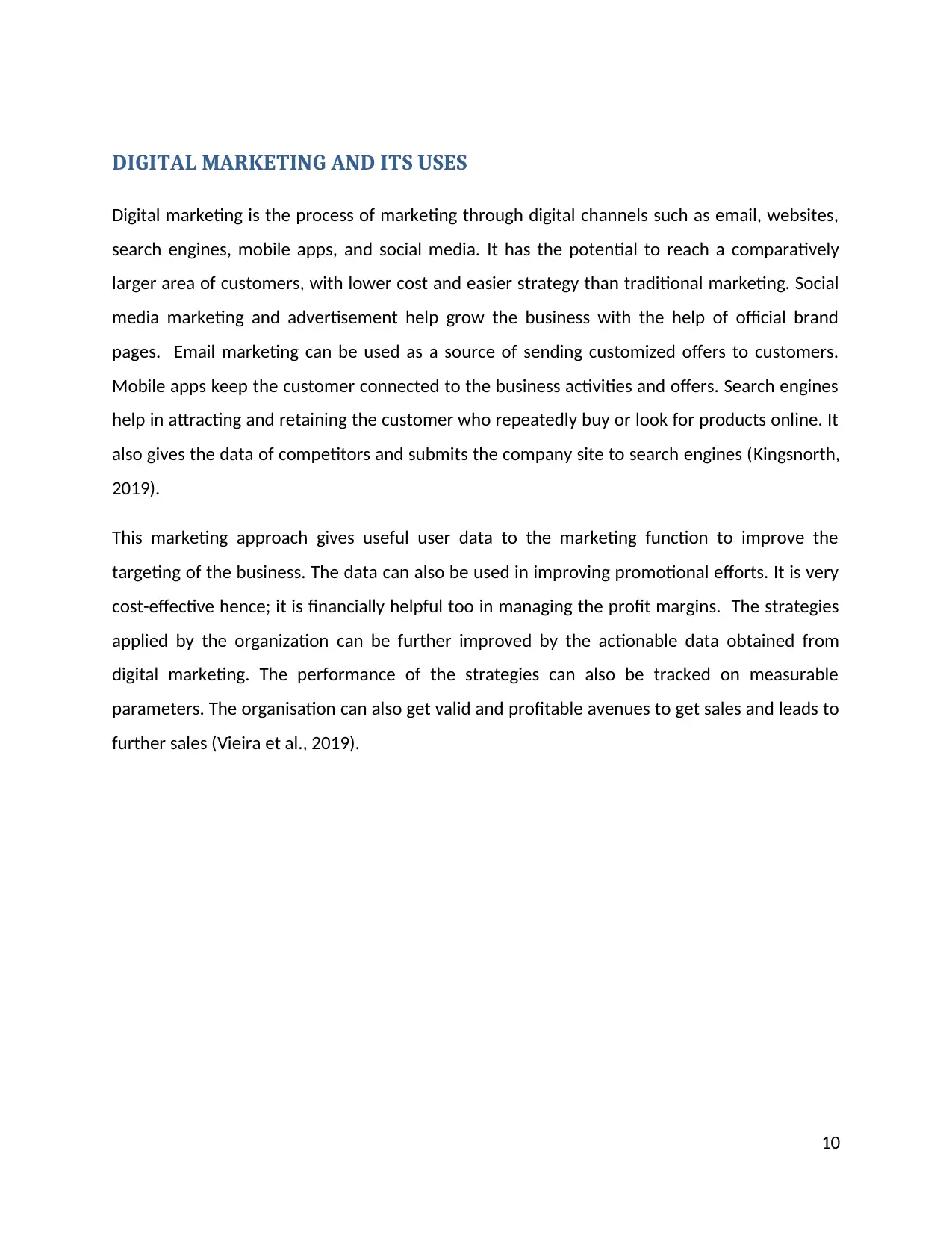
DIGITAL MARKETING AND ITS USES
Digital marketing is the process of marketing through digital channels such as email, websites,
search engines, mobile apps, and social media. It has the potential to reach a comparatively
larger area of customers, with lower cost and easier strategy than traditional marketing. Social
media marketing and advertisement help grow the business with the help of official brand
pages. Email marketing can be used as a source of sending customized offers to customers.
Mobile apps keep the customer connected to the business activities and offers. Search engines
help in attracting and retaining the customer who repeatedly buy or look for products online. It
also gives the data of competitors and submits the company site to search engines (Kingsnorth,
2019).
This marketing approach gives useful user data to the marketing function to improve the
targeting of the business. The data can also be used in improving promotional efforts. It is very
cost-effective hence; it is financially helpful too in managing the profit margins. The strategies
applied by the organization can be further improved by the actionable data obtained from
digital marketing. The performance of the strategies can also be tracked on measurable
parameters. The organisation can also get valid and profitable avenues to get sales and leads to
further sales (Vieira et al., 2019).
10
Digital marketing is the process of marketing through digital channels such as email, websites,
search engines, mobile apps, and social media. It has the potential to reach a comparatively
larger area of customers, with lower cost and easier strategy than traditional marketing. Social
media marketing and advertisement help grow the business with the help of official brand
pages. Email marketing can be used as a source of sending customized offers to customers.
Mobile apps keep the customer connected to the business activities and offers. Search engines
help in attracting and retaining the customer who repeatedly buy or look for products online. It
also gives the data of competitors and submits the company site to search engines (Kingsnorth,
2019).
This marketing approach gives useful user data to the marketing function to improve the
targeting of the business. The data can also be used in improving promotional efforts. It is very
cost-effective hence; it is financially helpful too in managing the profit margins. The strategies
applied by the organization can be further improved by the actionable data obtained from
digital marketing. The performance of the strategies can also be tracked on measurable
parameters. The organisation can also get valid and profitable avenues to get sales and leads to
further sales (Vieira et al., 2019).
10
Paraphrase This Document
Need a fresh take? Get an instant paraphrase of this document with our AI Paraphraser
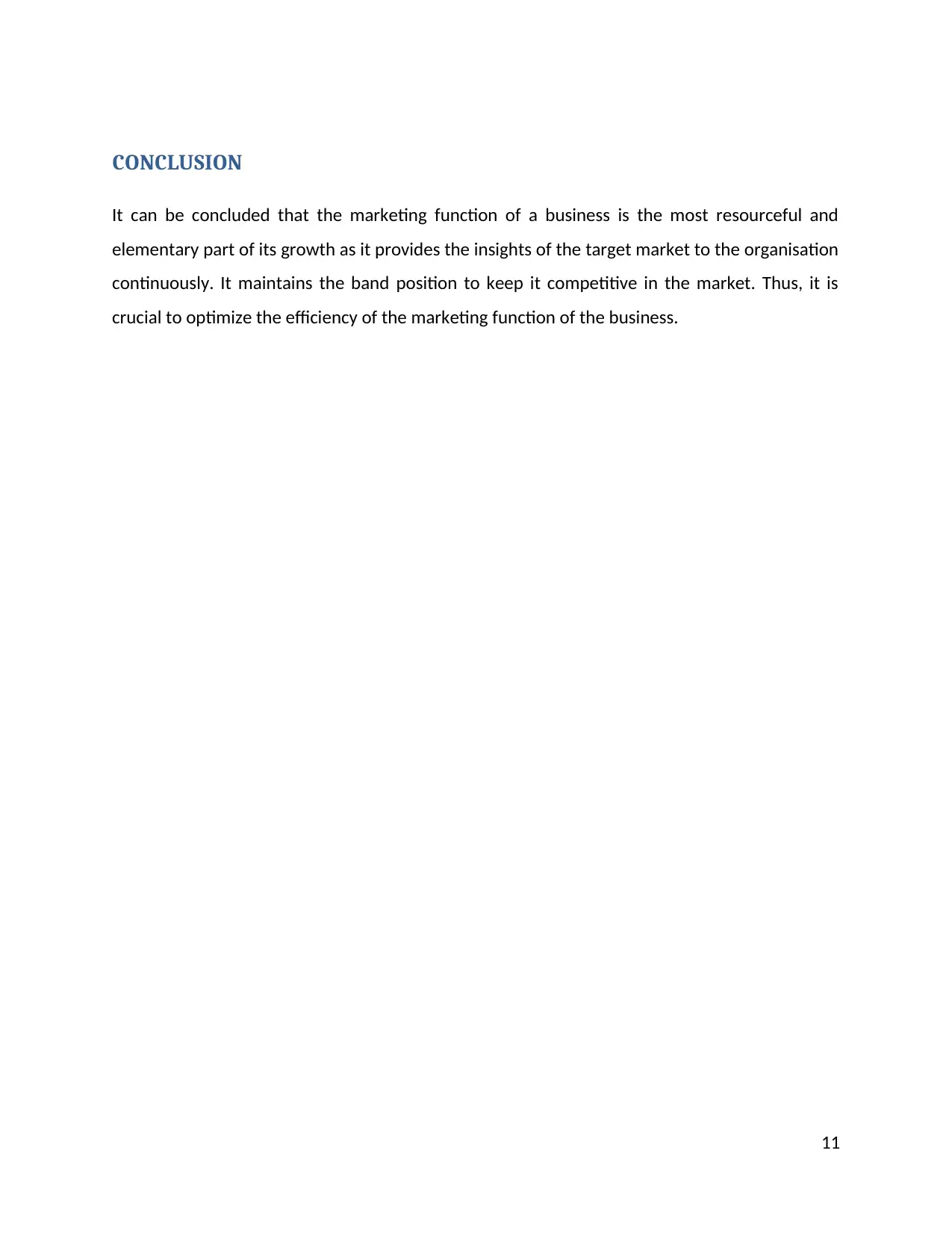
CONCLUSION
It can be concluded that the marketing function of a business is the most resourceful and
elementary part of its growth as it provides the insights of the target market to the organisation
continuously. It maintains the band position to keep it competitive in the market. Thus, it is
crucial to optimize the efficiency of the marketing function of the business.
11
It can be concluded that the marketing function of a business is the most resourceful and
elementary part of its growth as it provides the insights of the target market to the organisation
continuously. It maintains the band position to keep it competitive in the market. Thus, it is
crucial to optimize the efficiency of the marketing function of the business.
11
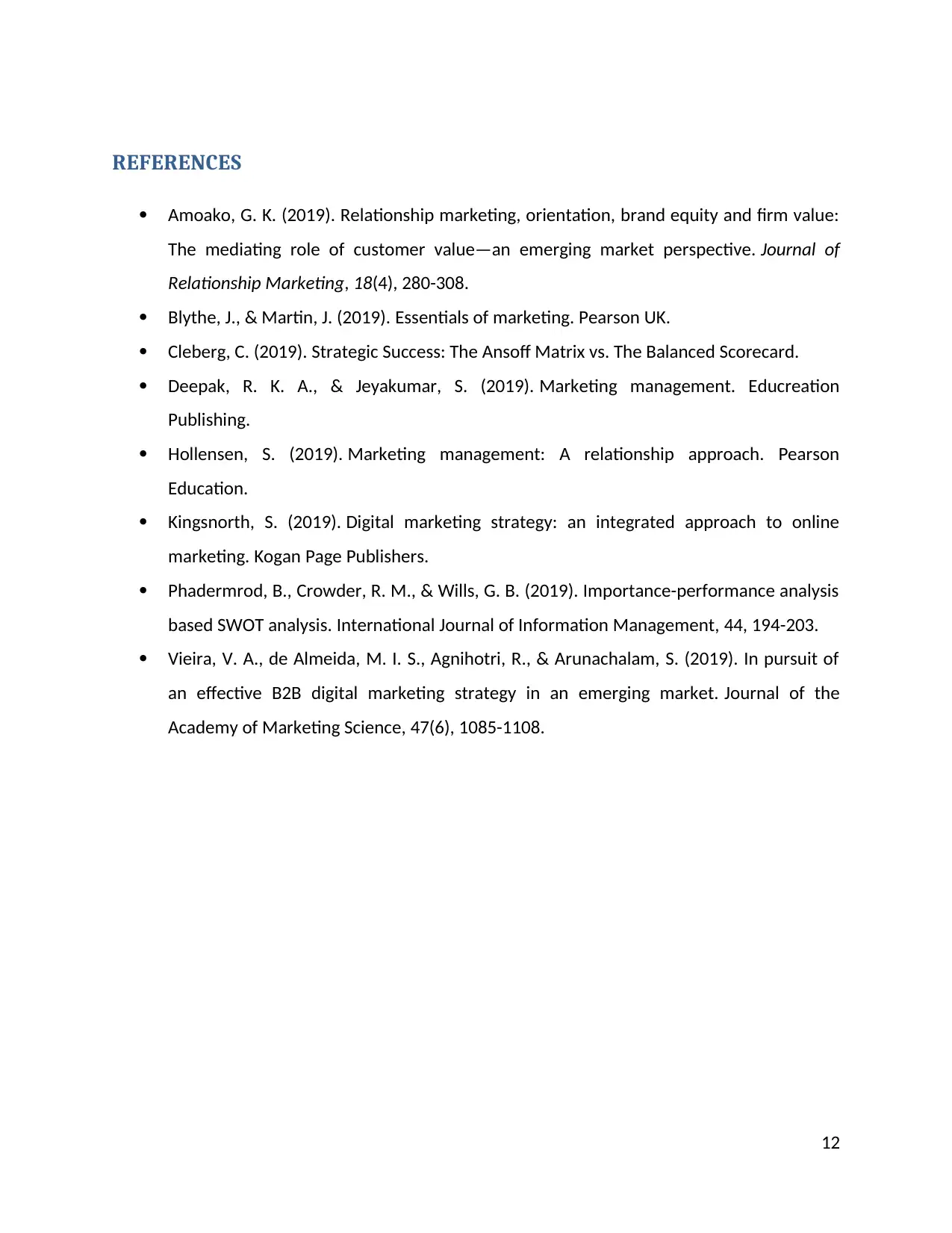
REFERENCES
Amoako, G. K. (2019). Relationship marketing, orientation, brand equity and firm value:
The mediating role of customer value—an emerging market perspective. Journal of
Relationship Marketing, 18(4), 280-308.
Blythe, J., & Martin, J. (2019). Essentials of marketing. Pearson UK.
Cleberg, C. (2019). Strategic Success: The Ansoff Matrix vs. The Balanced Scorecard.
Deepak, R. K. A., & Jeyakumar, S. (2019). Marketing management. Educreation
Publishing.
Hollensen, S. (2019). Marketing management: A relationship approach. Pearson
Education.
Kingsnorth, S. (2019). Digital marketing strategy: an integrated approach to online
marketing. Kogan Page Publishers.
Phadermrod, B., Crowder, R. M., & Wills, G. B. (2019). Importance-performance analysis
based SWOT analysis. International Journal of Information Management, 44, 194-203.
Vieira, V. A., de Almeida, M. I. S., Agnihotri, R., & Arunachalam, S. (2019). In pursuit of
an effective B2B digital marketing strategy in an emerging market. Journal of the
Academy of Marketing Science, 47(6), 1085-1108.
12
Amoako, G. K. (2019). Relationship marketing, orientation, brand equity and firm value:
The mediating role of customer value—an emerging market perspective. Journal of
Relationship Marketing, 18(4), 280-308.
Blythe, J., & Martin, J. (2019). Essentials of marketing. Pearson UK.
Cleberg, C. (2019). Strategic Success: The Ansoff Matrix vs. The Balanced Scorecard.
Deepak, R. K. A., & Jeyakumar, S. (2019). Marketing management. Educreation
Publishing.
Hollensen, S. (2019). Marketing management: A relationship approach. Pearson
Education.
Kingsnorth, S. (2019). Digital marketing strategy: an integrated approach to online
marketing. Kogan Page Publishers.
Phadermrod, B., Crowder, R. M., & Wills, G. B. (2019). Importance-performance analysis
based SWOT analysis. International Journal of Information Management, 44, 194-203.
Vieira, V. A., de Almeida, M. I. S., Agnihotri, R., & Arunachalam, S. (2019). In pursuit of
an effective B2B digital marketing strategy in an emerging market. Journal of the
Academy of Marketing Science, 47(6), 1085-1108.
12
⊘ This is a preview!⊘
Do you want full access?
Subscribe today to unlock all pages.

Trusted by 1+ million students worldwide
1 out of 12
Related Documents
Your All-in-One AI-Powered Toolkit for Academic Success.
+13062052269
info@desklib.com
Available 24*7 on WhatsApp / Email
![[object Object]](/_next/static/media/star-bottom.7253800d.svg)
Unlock your academic potential
Copyright © 2020–2025 A2Z Services. All Rights Reserved. Developed and managed by ZUCOL.



